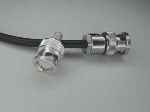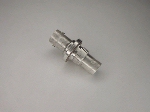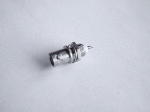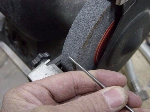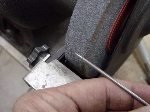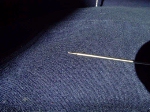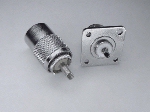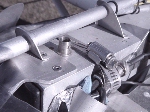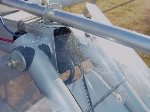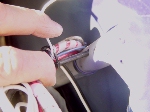The Antenna
A quarter-wave antenna is theoretically 36 ohms since it's half of a dipole antenna which is 72 ohms. The dipole antenna needs no ground plane but can you imagine a 46" antenna sticking up somewhere on the outside of our plane??? About the only place I could see doing that would be a half-wave dipole attached vertically to the wing spar/strut juncture.... weird!
On a dipole, the shield of the coax feeds one half of the antenna while the center wire of the coax feeds the other half. In a quarter-wave antenna installation, the coax's center wire feeds the insulated antenna element while the shield "feeds" the ground or is grounded to the metal structure. The metal material (aircraft structure) around the antenna becomes the other half of the antenna system.
The formula for figuring a half wavelength is: 492 / freq(in MHz) x 12 to give the length in inches. Therefore, to figure a quarter wavelength, the formula would be: 246 / freq(MHz) x 12. However, those figures are generally for frequencies below 30 MHz or so (shortwave bands). It's been found that as your frequency increases above 30 MHz or so, the ends of the antenna begin to affect the real world length and calculations need a reduction of about 5%. So we use a slightly different formula: 236/freq (MHz) for antenna lengths at our operating frequencies.
Example: find a quarter-wave antenna length for a 121 MHz operating
frequency.
(236/121x12) 236 / 121 = 1.95' x 12" = 23.4" for the rod.
The ground plane radials would be 5% more or about 24.6". If they are longer, it's not a problem.
If, for example, you use 118.0 MHz for the lower end of your "operating range of channels" and 126 MHz for the upper end, you'll find that the center frequency will be 122 MHz. Therefore if you cut your antenna for 122 MHz it will be the most efficient at that frequency with a (very) slight loss at 118 and 126. This loss will probably only be measurable with fancy test equipment. The engths for those two frequencies will be approximately 23.8" for 118 MHz and approximately 22.3" for 126 MHz. So we have a difference of 1.5" over that 8 MHz channel spread. This is why we say the length is nothing to get really anal about. In our 121 MHz example, a half inch either way from the 23.4" calculation will work just fine. Of course, there comes a point where the SWR *is* a problem but, for our purposes, we can ignore it since the "window of operation" naturally limits the problem for us.
The ground plane, or counterpoise as it's properly called, sits at the base or feedpoint (where the coax is connected) of the antenna. Ideally, the ground plane would be a disc with a radius 5% or more than the active (vertical) element or, in our example of 23", about 24-1/4". However, on our aircraft, this is not practical. We can use 4 wires or rods in place of the disc with excellent results but again, depending on the aircraft/application, it may not be practical. We can, however, get quite acceptable results by using the existing root and down tubes as a ground plane. Mounting the antenna out on the wing strut attach bracket will utilize the wing spar and strut, also with good results. An L-shaped bracket can used for the antenna mount on both the wing spar/strut location and works equally well for the root tube if you have no desire to drill a hole in that tube. |
